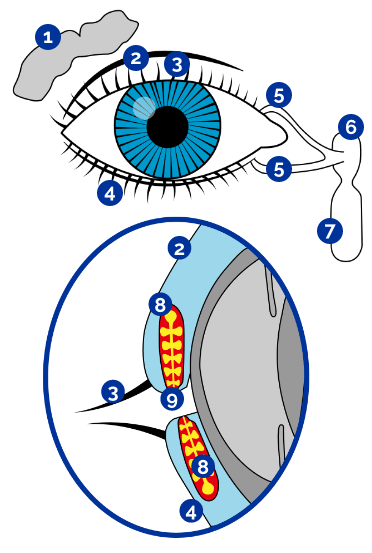
What is dry eye disease?
Dry eye disease, also known as dry eye syndrome, is a common eye disorder where the eyes don’t make enough tears or the tears evaporate too quickly. It can make your eyes feel dry, scratchy and irritated or watery, and feel heavy and tired at the end of the day. Usually, it does not cause long-term problems with your sight, but can cause fluctuating blurriness.
Dry eye is more common as we get older, and is exacerbated by time spent in front of computer screens and in airconditioned environments. One in every three people over the age of 65 experience problems with dry eyes.
Dry eye disease is a chronic, long-term condition. Treating and managing your dry eye early can prevent permanent damage to the surface of the eye and therefore stop future vision loss. If you experience any of the symptoms of dry eye disease you should speak with your GP or optometrist who may refer you to an eye specialist, known as an ophthalmologist. Keeping the eye surface and tear film healthy is also important for successful management of glaucoma.
Structure of the eye and eye surface
The eye is shaped like a ball, and has a tough white outer layer called the sclera. The surface of the sclera is covered by a thin translucent layer called the conjunctiva. The sclera has a clear section at the front of the eye called the cornea, which is protected by the tear film.
Several glands containing cells that produce different substances, in the eyelids and within and under the conjunctiva, help produce the tear film, including the lacrimal glands and meibomian glands.

-
Lacrimal gland
-
Upper eyelids
-
Eyelashes
-
Lower eyelids
-
Puncta
-
Tear sac
-
Tear duct
-
Meibomian glands
-
Ducts of the meibomian glands
What makes tears?
Each time we blink, our eyelids create a new layer of tears over the front of the eye. Tears have three main components:

-
Mucous inner layer
Produced by mucous cells in the conjunctiva. This is healthy in most people. -
Watery (aqueous) middle layer
This is produced by lacrimal glands, also known as tear glands, through openings in the upper eyelid. As we get older, particularly in women after menopause, the lacrimal gland produces less watery tears. -
Oily outer layer
Produced by the meibomian oil glands in the eyelids, which have openings just behind the eyelashes on both the upper and lower eyelids. Problems with these glands are the most common cause of dry eye disease. This smooth layer of tears acts like a waterproof barrier. It stops the watery tears from evaporating.
Why are tears important?
A smooth layer of tears is essential for sharp vision. If the tear film has patchy areas where it has dried out, the light that hits the eye is scattered and does not focus clearly. A patchy, poor quality tear film also leads to discomfort and irritation.


